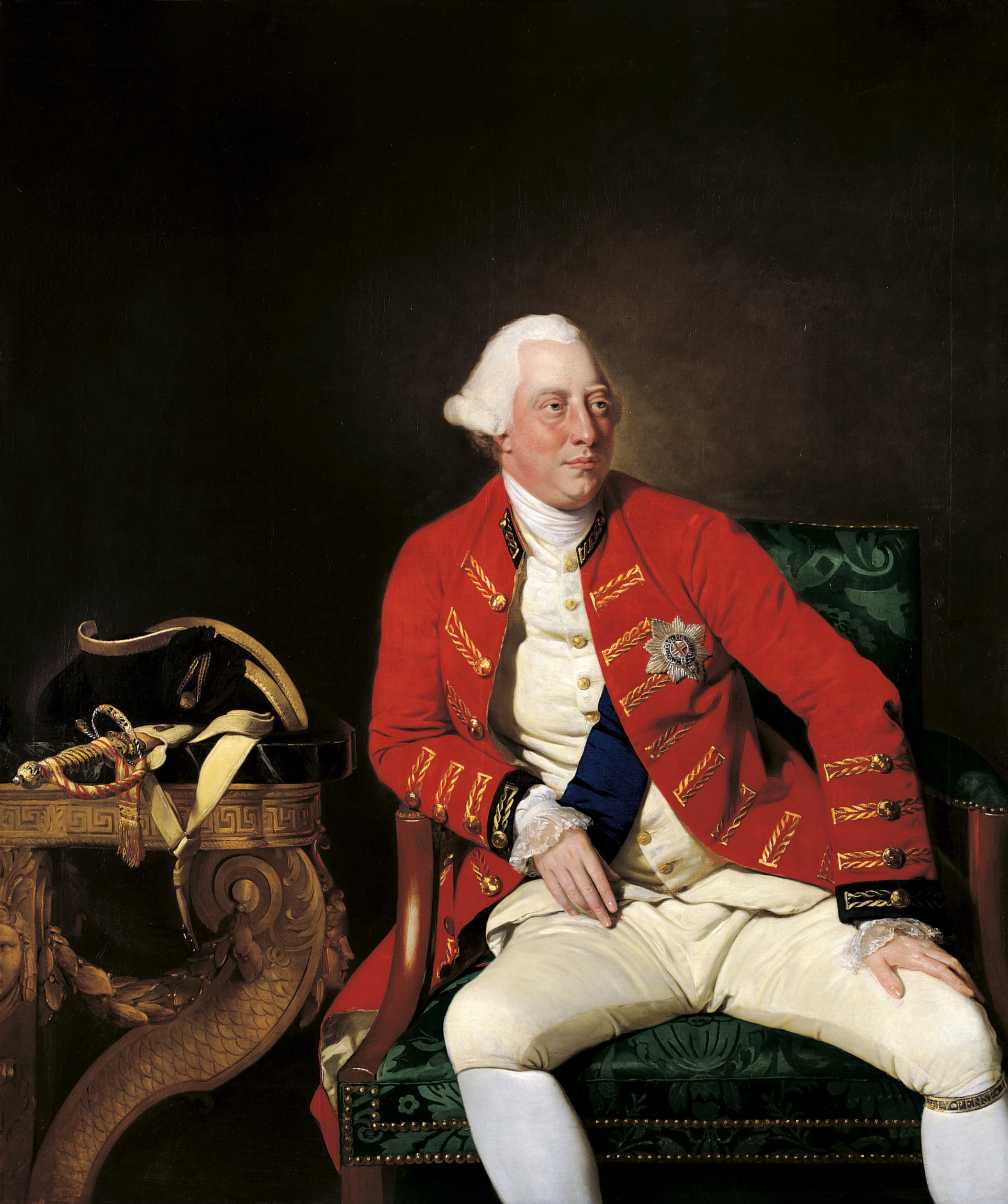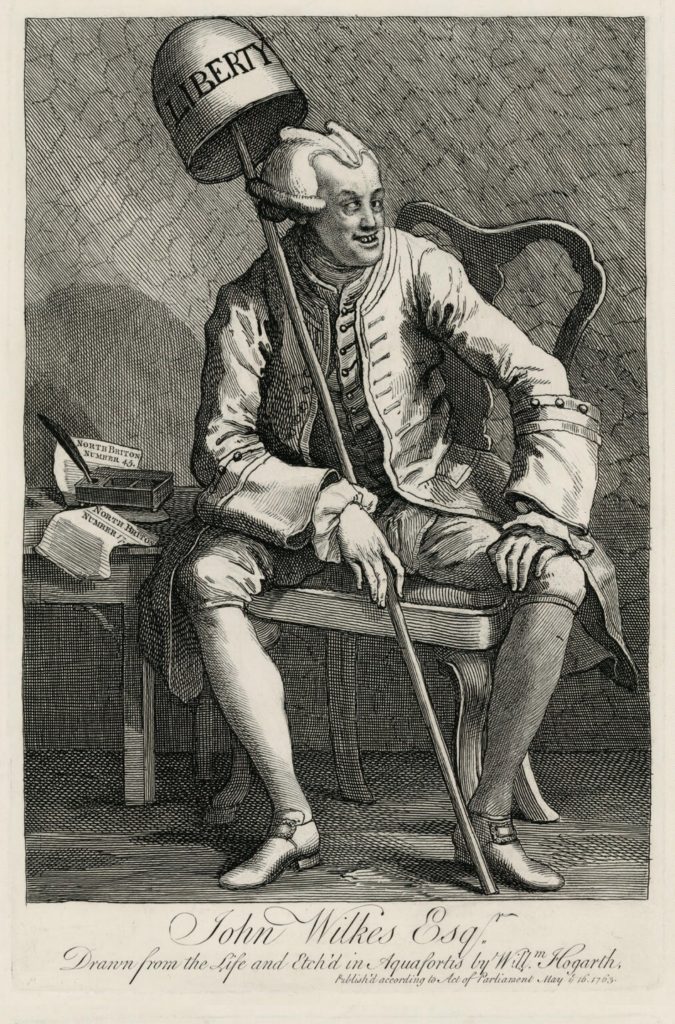
Johan Josef Zoffany’s 1771 portrait of George III reflects at once his aspiration to be a patriot king and the discord eroding the unity of his empire. The oil painting is so unlike any previous royal portrait that it created a sensation when it was first displayed. Never before had a British monarch been portrayed in such an informal manner. The setting, with its elaborate gilded table topped with marble and a finely upholstered chair, is elegant, but not regal. A tricorn hat and sword take the place of the crown and scepter usually depicted in royal portraits. Zoffany portrayed the king as a self-confident, untroubled man, at ease in his role. He looks relaxed and resolute. His right arm rests casually on the arm of the chair. His left hand rests on his thigh, pointed in the direction he is looking, out of the frame to the viewer’s right.
Despite the portrait’s air of elegant informality, no contemporary viewer could have confused the sitter with a country squire. He wears a military officer’s coat and the sash and star of the Order of the Garter, England’s highest order of chivalry, in which membership was limited to the sovereign and twenty-four companions chosen by the king. The garter below his left knee is part of the order’s insignia, and bears the motto “Honi soit qui mal y pense,” meaning “Shame on him who thinks ill of it.” Membership in the order was the highest of the many honors at the king’s disposal.
By emphasizing the king’s role as head of the order, the portrait appealed to a very traditional idea of the king unifying the realm by drawing the landed aristocracy together under his leadership through the distribution of honors. Despite his determination to promote the best interests of all his subjects, the king had no clear conception of how to deal with the changing and increasingly fractious—and even rebellious—nature of popular politics and its leaders. Fueled by an increasing volume of pamphlets, leaflets, broadsides and inexpensive news sheets, often scurrilous and filled with invective, the political world of the coffee houses and the streets was increasingly remote from the aristocrats upon whom the king relied and through whom he sought to maintain harmony in his realm. Its leaders, whether in London or Boston, had little regard for honors bestowed at court. They operated outside the traditional structure of political power, in which order was maintained through the distribution of offices, sinecures and favors through networks associated with aristocrats.
In 1771, the most prominent popular leader of this sort was John Wilkes, a daring political writer and politician whose attacks on the king’s ministers had undermined George III’s posture as a patriot king for nearly a decade. Wilkes was elected to parliament from Buckinghamshire in 1757. When George III installed Lord Bute as prime minister in 1762, Wilkes launched a campaign of invective against his ministry. Wilkes was arrested in 1763 under a general warrant for attacking the king’s speech on peace with France in his newspaper, The North Briton. After his release Wilkes fled to France, was expelled from the House of Commons and was outlawed for publishing libels.
 At the height of the controversy, William Hogarth published an unflattering caricature of Wilkes, depicting him as a leering emblem of licentiousness and political discord with his inflammatory news sheets at his side and holding a staff topped with a liberty cap. (The version shown here, published by Hogarth in 1763, is from the collections of the National Portrait Gallery, London.) Though intended to ridicule Wilkes, the print was taken up by his supporters as a symbol of their idol. It even even appeared on punch bowls and other commemorative items celebrating the radical politician who had stood up to the king’s ministers. Wilkes returned from France in 1768 and resumed his popular agitation. In 1769 he and his associates formed the Society of Gentlemen Supporters of the Bill of Rights, which published a manifesto in 1771 calling for annual parliaments, electoral reforms, the “full and equal representation of the people,” the abolition of all excise taxes and the end to all taxation of the American colonies without the colonists’ consent.
At the height of the controversy, William Hogarth published an unflattering caricature of Wilkes, depicting him as a leering emblem of licentiousness and political discord with his inflammatory news sheets at his side and holding a staff topped with a liberty cap. (The version shown here, published by Hogarth in 1763, is from the collections of the National Portrait Gallery, London.) Though intended to ridicule Wilkes, the print was taken up by his supporters as a symbol of their idol. It even even appeared on punch bowls and other commemorative items celebrating the radical politician who had stood up to the king’s ministers. Wilkes returned from France in 1768 and resumed his popular agitation. In 1769 he and his associates formed the Society of Gentlemen Supporters of the Bill of Rights, which published a manifesto in 1771 calling for annual parliaments, electoral reforms, the “full and equal representation of the people,” the abolition of all excise taxes and the end to all taxation of the American colonies without the colonists’ consent.
Zoffany’s extraordinary portrait of George III claimed for the king the populist role occupied by Wilkes by appropriating the very pose—seated, legs splayed, left hand resting on the subject’s left thigh, and face turned to the viewer’s right—Hogarth had used in his famous caricature of Wilkes. In place of Wilkes’ pen and inflammatory news sheets, Zoffany placed the king’s hat and sword, which the self-assured king, in his military attire, was prepared to take up in defense of the realm. In place of the leering, licentious Wilkes, the symbol of discord and faction, Zoffany presented George III as a patriot king.
Coming Soon-Explore John Wilkes